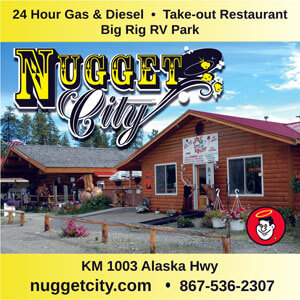How Long Does It Take To Get To Alaska
Alaska Highway
The Alaska Highway, also known as the Alaskan Highway or the Alcan Highway, is the 2,224 Km/1382 mile road that connects Dawson Creek, BC in Canada to Delta Junction, Alaska. It is a mostly paved or chip sealed highway, which is open year round and passes through the rugged northern landscape of British Columbia, Yukon and Alaska.
The Alaska Highway was the engineering marvel of World War II and was once described as the largest and most difficult construction project since the Panama Canal. The highway is often referred to as the Alcan Highway, which came from shortening "Alaska and Canada Highway." Whether this is your first time driving to Alaska or you're a seasoned traveler of the Alcan, we hope the following information will be helpful in determining if you can drive to Alaska. You can view our handy Alaska Highway Map PDF here. You can also download our PDF mile-by-mile road log to use when driving to Alaska and unable to access the internet. Don't forget to pickup a copy of our Alaska Highway Mapbook as your handy companion for your trip north. It's full of detailed maps of highways and towns. You can view it further down this page.
Visitors looking to drive to Alaska in 2021 need to be aware of enhanced border restrictions for people crossing the border during the pandemic. Click the link to read more about Coronavirus in Alaska.
For a complete list of Things to do in BC, the Yukon and Alaska on your trip north, visit our Things To Do section. For information on places to camp, visit our section on camping in Alaska. To determine when you should plan your trip to Alaska, visit our page on the best time to visit Alaska. Finally, many visitors to the north want to experience the Northern Lights, so we've put together a page of detailed information on how and when to see the Northern Lights in Alaska.
Driving to Alaska on the Alaska Highway
Many visitors want to know if you can drive to Alaska on the Alaska Highway. The answer is yes! If you drive to Alaska you must drive through Canada. If you drive to Alaska you will need to drive through the province of British Columbia and the Yukon Territory.
The Alaska Highway is 2,224 Km/1382 miles long and stretches from Dawson Creek, British Columbia to Delta Junction, Alaska. It was originally a 1422 mile long drive to Alaska, but due to highway re-construction and re-routing, it is now 40 miles/64 km shorter. Alaska, however, has not changed the original mileposts, so there is a mileage discrepancy of 40 miles when you cross the Alaska/Yukon border. Many people think the Alaska Highway ends in Fairbanks, Alaska, but it is actually the Richardson Highway that connects Delta Junction and Fairbanks.
Do you need a Passport to drive to Alaska?
Yes, you will need a Passport to drive to Alaska, as the majority of the Alaska Highway is in Canada (1182 miles of the total 1422 miles). A passport is required for all visitors to enter Canada by land, sea or air. Driving to Alaska in 2021 has been complicated due to the pandemic restrictions in place for crossing the border (click here for updated entry requirements). Regulations are constantly changing, but you may be required to provide proof of a negative COVID-19 test and quarantine for up to 14 days.
It is possible to fly to Alaska from any U.S. state without a passport, as you won't be crossing international borders. When driving through Canada, most travelers choose one of two routes to reach the beginning of the Alaska Highway in Dawson Creek. Either through British Columbia or through Alberta. The Alberta route can include stops in Banff and Jasper, which are beautiful places to visit in the Canadian Rockies. The route through British Columbia will lead through Prince George and onto the Hart Highway to Dawson Creek, the beginning of the Alcan Highway.
Is the Alaska Highway Paved?
Yes, the Alaska Highway is paved. The highway surface is paved or chip sealed (which is more common) from beginning to end, however, there are still rough patches, large bumps and plenty of summer construction to watch for. Most of the rough highway conditions are marked by signs or red markers/flags on the side of the road, but not all, so stay alert. You may encounter long sections of new chip seal which can be very dusty so drive with your headlights on at all times. Finally, pay close attention to all highway signs as the Alcan Highway conditions can change quickly.
The Alaska Highway starts in Dawson Creek, British Columbia and ends Delta Junction, Alaska. From Dawson Creek, the Alaska Highway runs 970 km/595 miles to Lower Post where it enters the Yukon. It then winds its way through the Yukon for another 892 km/550 miles, passing through Whitehorse and crossing into Alaska at mile 1182/km 1903. From the Alaska border the Alcan Highway Continues on to Delta Junction at mile 1422/km 2224, where the Alaska Highway joins the Richardson Highway for the remaining 98 miles/158 km to Fairbanks AK.

We have broken our Alaska Highway Road Log into five sections:
The Alaska Highway From Dawson Creek to Ft. Nelson
From KM 0 in Dawson Creek to Fort Nelson at KM 454. This section of highway passes through most of the BC portion of the Alcan Highway.
The Alaska Highway From Ft. Nelson to Watson Lake
From KM 454 to Watson Lake at KM 980. Watson Lake is the first town in the Yukon.
The Alaska Highway From Watson Lake to the Alaska Border
From KM 980 to the Alaska/Yukon Border at KM 1903. The highway passes through Whitehorse, the capital of the Yukon.
The Alaska Highway From the Alaska Border to Delta Junction
From Mile 1222 to Delta Junction at Mile 1422, the official end of the Alaska Highway.
View Our Alaska Highway Mapbook Below.
Alcan Highway History
The drive to Alaska truly began as a wilderness trail with gravel roads, steep grades, muskeg and log bridges to navigate. The difficult and exhausting work inspired one poet to write:
'The Alaska Highway, winding in and winding out, fills my mind with serious doubt, as to whether 'the lout' who built this route, was going to hell or coming out!'
It also took unprecedented cooperation between the Canadian and United States governments to make construction possible. In 1936, President Franklin D. Roosevelt lobbied Canadian Prime Minister Mackenzie King for a highway connecting Canada and Alaska. The highway could be used to shore up military defenses on the west coast in case of a Japanese attack. It wasn't until the attack on Pearl Harbor that both Nations agreed on the importance of such a road and quickly put the wheels in motion.
The United States Army approved a plan for the construction of the Alaska Highway on February 6, 1942 and received authorization from the U.S. Congress and President Roosevelt only five days later. Canada agreed to the construction, however it required the United States to pay the full cost of building the highway. All facilities in Canada were to be turned over to Canadian authority at the end of the war. Less than a month later, on March 8, 1942 construction began.
More than 11,000 soldiers and engineers, 16,000 civilians and 7000 pieces of equipment were called upon to build this 1500 mile road through the vast wilderness of northern Canada and Alaska. In less than nine months these hardy men managed to connect Dawson Creek, British Columbia and Delta Junction, Alaska. And, on November 20, 1942, the official ribbon cutting took place at mile 1061, known as "Soldiers Summit."
The successful completion of the Highway in such a short time was accomplished by having teams start in both Dawson Creek and Fort Nelson and work their way north. Meanwhile, two other teams started in Whitehorse and worked in opposite directions; one southeast towards Dawson Creek and one northwest towards Alaska. The fifth and final team pushed the road through from Delta Junction to the Canadian Border. The final tally for the Alaska Highway was approximately $140 million U.S. dollars, making it the most expensive construction project of World War II.
Here are some more frequently asked questions about driving to Alaska on the Alcan Highway.
Is the Alaska Highway dangerous?
No, the Alaska Highway is not a dangerous highway. It is a well maintained paved road with wide shoulders . Motorists should not be concerned about planning a trip on the Alaska Highway.
What is the speed limit on the Alaska Highway?
The speed limit on the Alaska Highway ranges from 50mph to 65mph. On the Canadian section the speed limits range from 50mph (80 km/h) to 60mph (100 km/h). In Alaska, the speed limit ranges from 55mph (90 km/h) to 65mph (105 km/h).
How long does it take to drive from Seattle to Anchorage?
It takes 43 hours of driving time to drive from Seattle to Anchorage. however, most people need to stop to rest, so even a very fast paced trip would take three to four days.
Can you drive to Alaska in April?
Yes you can drive to Alaska in April. The roads to Alaska are open year round. Keep in mind that although Spring has started in most of the United States by April, in Northern Canada and Alaska it can still be cold and snowy. This makes the drive to Alaska in April more challenging than later months.


How Long Does It Take To Get To Alaska
Source: https://www.bellsalaska.com/highway/alaska-highway/
Posted by: dietzcorescoleat.blogspot.com

0 Response to "How Long Does It Take To Get To Alaska"
Post a Comment